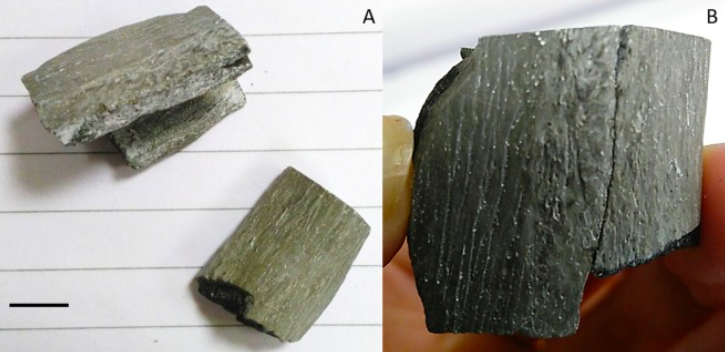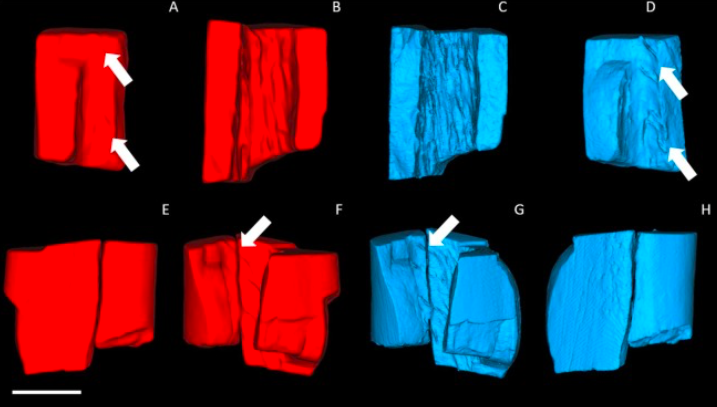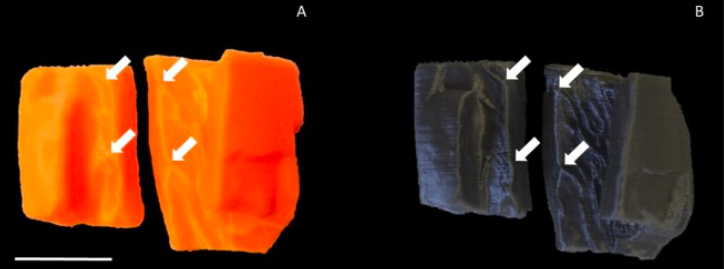A recent study, conducted by researchers Amber Collings and Katherine Brown at Teeside University in the U.K., analyzed the suitability of specific 3D scanning and modeling techniques in a key aspect of forensic investigation: physical fit analysis (PFA). PFA determines if two pieces of evidence physically fit together, their shared origin, the links between crime scenes and suspects, as well as allowing for object reconstruction for interpretation or presentation, to experts or jurors.
Forensic investigation can be challenging, especially when the evidence is damaged, fragmented, fragile, embedded or hazardous. In PFA, where human bone fragments are manually handled, difficulties arise in matching, reconstructing, interpreting, and presenting the evidence or results of the PFA. The bone fragments may be too small or complex or biologically hazardous. 3D imaging, modeling and printing has already been used broadly to improve or assist in forensics, particularly for complex anthropological evidence. Whether through physical reconstruction or virtual 360 models (built using 3D surface or volume-imaging technique), the use of non-contact 3D technologies has allowed forensics to address issues in visualization, virtual and physical bone reconstruction, matching wounds to weapons, dismemberment and more.
In this study, with burned skull bone fragments as evidence, researchers studied and compared the effectiveness of two imaging techniques to study and 3D print models for use in PFA. Micro computed tomography (µCT) scanning—a more accurate, volume-scanning technique—was compared with structured light scanning, a surface-scanning technique, in terms of effectiveness and efficiency of the virtual model, while fused deposition modeling (FDM) was compared with selective laser sintering (SLS) for the physical 3D model.
While both imaging techniques provided sufficient detail to allow for matching, alignment, and reconstruction, there were differences in efficiency, ease-of-implementation, accuracy and capability. Structure light scanning is cheaper, easier to implement and use, though its lower resolution and limitation in capturing only surface detail meant it was better suited to visualization than fit assessment. It also requires adjustments and sprays to capture the finer details of black or shiny fragments, limiting its ability to be safely handled or used for reconstruction.
µCT provides a far more complete, detailed 3D image, yet requires more expertise and specialized resources. Since it captures volumetric information it also requires much larger amounts of data. µCT provided better results if a thorough, non-destructive PFA needed to be conducted. Particularly when the evidence involved small, burned bone fragments, in reconstruction of actual or scaled virtual or physical models. Yet structured light scanning proved to be a more feasible alternative for purely visualization purposes.
In terms of 3D printing the models, FDM was a much cheaper alternative to SLS, with the Prusa i3 model (>$1300) priced a hundred times less than laser sintering machines ($5000-175,000). The latter results in far more accurate models and does not require supports but may be prohibitively expensive and requires specialized expertise to operate.
In this study, however, the researchers showed that using FDM was sufficient—by working around issues arising from support structures, hanging features using positioning/orientation, they were able to create accurate, effective 3D models for PFA, thus concluding that, “Fused filament deposition (FFD) 3D printing proved to be an accurate and useful method for creating physical replicas of the bone fragments to perform physical fit analysis (PFA) and bone fragment reconstruction.”
“We therefore recommend μCT imaging paired with FFD 3D printing as an excellent option for non-destructive physical fit confirmation when working with small fragments and burned bone.”
This reaffirms what several studies and recent applications have pushed forward: the combined use of 3D imaging, virtualization and printing can transform or improve forensic investigation, reconstruction, as well as juror understanding in court trials. Some of these applications include developing forensic devices, low-cost postmortem kits, resolving tough to crack cold cases, developing models for forensic training and testing, and more. It is without doubt that implementing 3D technologies significantly improve the speed, efficiency, safety, and capabilities in forensic investigation, thus enabling more accurate, well understood, criminal trial outcomes.
Subscribe to Our Email Newsletter
Stay up-to-date on all the latest news from the 3D printing industry and receive information and offers from third party vendors.
You May Also Like
Printing Money Episode 18: The DC Fly-In with Mark Burnham, AddMfgCoalition
It’s only been a week since the previous show, but Printing Money is back already with Episode 18. Certain events call for Printing Money’s coverage, and the recent 2nd Annual...
3DPOD Episode 199: Collaborative Design with Graham Bredemeyer, CEO of CADchat
About a decade ago, entrepreneur Graham Bredemeyer started Collider, a company that combined the best of 3D printing with injection molding. Now he runs CADChat, which hopes to make sharing...
Printing Money Episode 17: Recent 3D Printing Deals, with Alex Kingsbury
Printing Money is back with Episode 17! Our host, NewCap Partners‘ Danny Piper, is joined by Alex Kingsbury for this episode, so you can prepare yourself for smart coverage laced...
3DPOD Episode 198: High Speed Sintering with Neil Hopkinson, VP of AM at Stratasys
Neil Hopkinson, a pioneering 3D printing researcher, played a pivotal role in developing a body of research that is widely utilized today. He also invented High Speed Sintering (HSS), also...




































